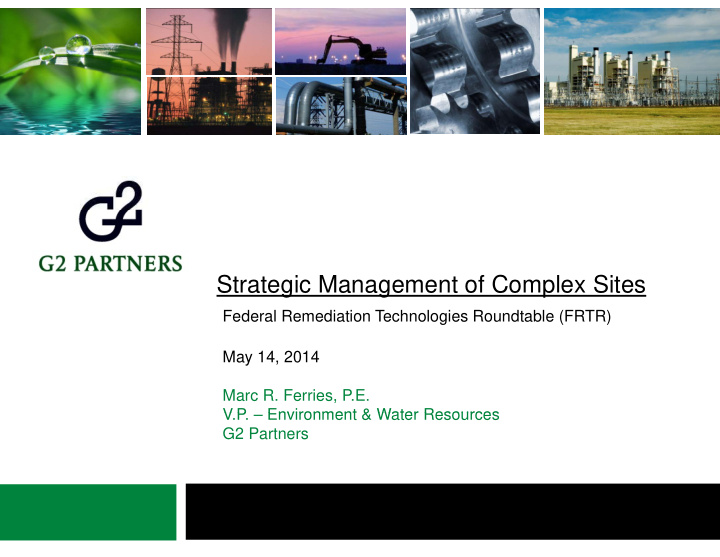



St Strategic Management of Complex Sites t i M t f C l Sit Federal Remediation Technologies Roundtable (FRTR) May 14, 2014 Marc R. Ferries, P.E. V P V.P. – Environment & Water Resources Environment & Water Resources G2 Partners
Topics for Discussion Topics for Discussion 2 Define complex site p Examples Enduring Commitment Develop Site Strategy Develop Site Strategy Identify Options Measure Site Progress Ultimate End-State Ultimate End State
Complex Remediation Sites Complex Remediation Sites 3 Areal extent of sites – regional impacts, drainage basins, miles of river, mining districts Contaminants occur naturally Primary remedy is waste in place a y e edy s was e p ace Ultimate cleanup requires in perpetuity management Uncertainty of remedial standards U t i t f di l t d d Solutions require integrated remedy
Yerington Former Copper Mine Yerington Former Copper Mine 4
Operating Anaconda Smelter Operating Anaconda Smelter 5
Montana NPL Sites Montana NPL Sites 6 Clark Fork River Anaconda Butte Butte Montana Pole
Berkeley Pit – Butte, MT Berkeley Pit Butte, MT 7
Enduring Commitment Enduring Commitment 8 These sites required an extensive commitment to endure through extensive data collection, negotiations and development of trust w/ stakeholders. Development of an advocacy & engagement plan is critical to success of your site objectives. Engagement with key stakeholders – community, and regulators Informing the public with regulatory agreement on environmental progress using Informing the public with regulatory agreement on environmental progress using strategic venues on a continuing basis Advocating for legislative and regulatory initiatives that promote reasonableness standards bl t d d Delivering messages through organizations, media (earned and otherwise), and third-party advocates Participating in programs that support or align with business objectives
Many Moving Parts Many Moving Parts 9 Sites within a SITE Holistic site conceptual Model Allow Sound Science to Lead Decisions Allow Sound Science to Lead Decisions Develop Trust w/ Stakeholders Pursue Reasonable Solutions
Develop a Strategic Plan Develop a Strategic Plan 10 Site Setting Location Ownership Site History Driving Forces Site Specific Legal Legal Regulatory Technical Contractual Exit Strategy Recommended Project Strategy Explanation of Strategy Selected Schedule Schedule Figures Economics Periodic Re-assessment of Site Scenarios
Options within Plan Options within Plan 11 Determine options available w/in strategic plan Options analysis Decision tree modeling D i i d li Financials – probabilistic cost estimating Determine appropriate Levers Determine appropriate Levers Formulate potential scenarios and develop potential outcomes Review the scenario results and revise assumptions as appropriate: p pp p Key drivers Logical outcomes Additional input form stakeholders Other Produce summary analysis and recommendations
Measure Progress Measure Progress 12 “If you can’t measure it, you can’t manage it.” Impacted sites require reduction of risks p q Risks can be defined as uncertainties Measure risk reduction to understand progress M i k d ti t d t d Risks based on site conditions Risks can be characterized as Technical or Non- Technical
Risk Categories Risk Categories 13 Technical Non-Technical Areal Extent of Onsite & Offsite A l E f O & Off Regulations R l contaminants Contractual Obligations Geology G gy Stakeholder Relationships Stakeholder Relationships LNAPL or DNAPL Litigation Concerns Potential Receptors Property Value Property Value Status of Delineation Contractual Agreements Acute and Chronic water quality Public Perception standards Re-vegetation/ Reclamation
Performance Model Performance Model 14
Risk Profile Risk Profile 15 Fields Baseline 120,000 $4,000,000 100,000 $3,000,000 80,000 E re x p o e c 60,000 $2,000,000 n I S d itu P re 40,000 $1,000,000 20,000 0 $0 1/1/2006 1/1/2008 1/1/2010 1/1/2012 1/1/2014 1/1/2016 1/1/2018 Baseline Expenditure NonTechnical Delineation Offsite GW Offsite Soil Offsite NAPL Onsite GW Onsite Soil Onsite NAPL
Potential Reports Potential Reports 16 Performance Indicators: Risk Reduction/Expenditures: • - Measure Cost Efficiency Meas re Cost Efficienc - Encourage Business Management Risk Reduction Slope Measure/Understand Impediments/ Risk Reduction Slope = Measure/Understand Impediments/ • • Cost of Delay/Apply Appropriate Resources Segregation of Site Risks: g g • Technical vs. Non-Technical, hydrocarbons, chlorinated compounds, and/or minerals, Onsite vs. Offsite, Community Relations, Consultants Promote Cash Flow Accuracy •
Implement Program Implement Program 17 Proceed through regulatory steps w/ a plan Allow sound science to drive protectiveness p Implement interim remedies Negotiate through open dialogues N ti t th h di l Demonstrate through science lead studies to promote risk-based standards including TI waivers Ultimately CD should include protective terms that y p are achievable
Progression to End State Progression to End State 18 Minimal Active Remediation/Reclamation Achievable Standards Achievable Standards Repeatable O&M Programs Water Treatment Systems W T S Monitoring Services – Groundwater/Surface Water IC’s Management to demonstrate protectiveness Address 5 year review findings - (Proactively vs. Reactively)
19 Transition Platform Transition Platform Insert Service Provider- Insert Service Provider Community/County/State or 3 rd Private Party Ensure Protectiveness Total Site Compliance Responsibilities Responsibilities
Questions Questions 20
Environmental & Water Resources Environmental & Water Resources 21 Remediation/Exit Strategy R di ti /E it St t • Support & Baselining for • Unconventional E&P Unconventional E&P Compliance • GIS Development & Data p • Management Community Engagement Program • Project Management • Environmental & ARO Disclosures, Environmental & ARO Disclosures, • Financial Reporting HSE Program Development & • Management
Recommend
More recommend